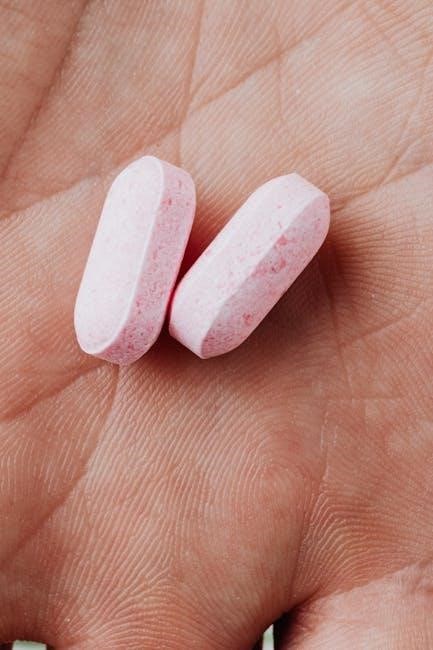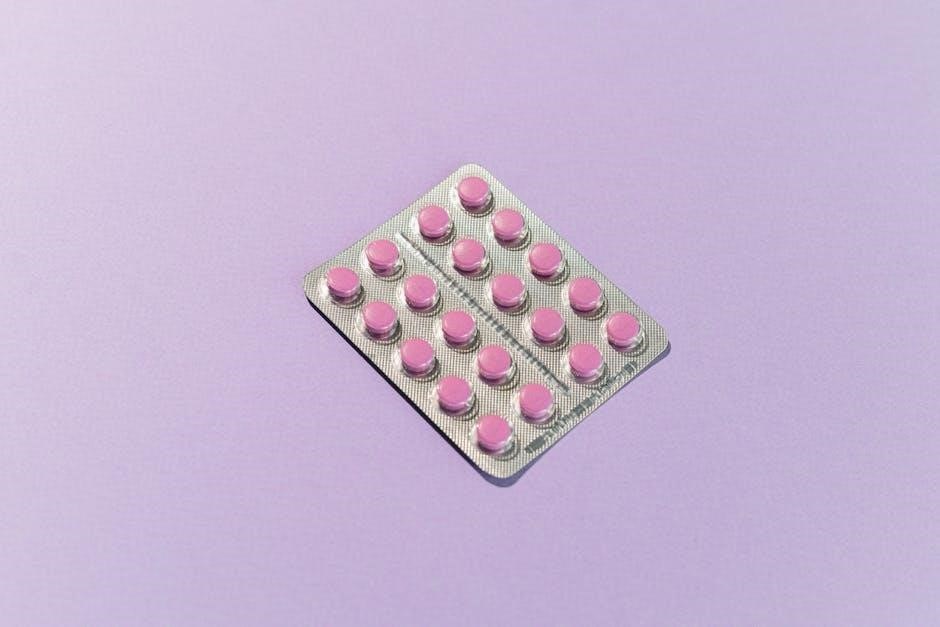Paramedic drug cards are essential tools for emergency medical professionals, providing quick reference for medication administration during critical situations. These cards detail drug names, dosages, and administration routes, serving as both field guides and study aids for paramedic training and certification exams. Their portability and concise format make them indispensable for rapid decision-making in high-stress environments, ensuring accurate and efficient patient care;
Overview of Paramedic Drug Cards
Paramedic drug cards are concise, portable references that summarize critical medication information for emergency medical services (EMS) professionals. They typically include details such as drug names, classifications, indications, dosages, side effects, and administration routes. These cards are designed to provide quick access to vital information during high-pressure situations, ensuring accurate and efficient patient care. They are widely used by paramedic students and professionals alike, serving as both a field guide and a study tool. Many resources, including free downloadable PDFs, offer customizable templates, allowing users to tailor drug cards to their specific needs or organizational preferences. This adaptability makes them an indispensable resource in paramedic practice and education.
Importance of Drug Cards in Paramedic Training
Drug cards are a cornerstone of paramedic training, offering a structured approach to mastering pharmacology. They enable paramedics to quickly recall critical drug information, ensuring accurate administration in emergency situations. By summarizing key details like dosages, indications, and side effects, drug cards simplify complex medication knowledge. They also serve as a valuable study tool, aiding in memorization and reinforcing understanding of pharmacological principles. Regular use of drug cards enhances decision-making skills, builds confidence, and prepares paramedics for the high-stress environments they will encounter. Their portability and accessibility make them an essential resource for both classroom learning and real-world application in patient care.

NREMT Paramedic Exam Preparation
Paramedic drug cards are vital for NREMT exam success, helping candidates master medication administration, dosages, and indications, ensuring confident and accurate responses during critical testing scenarios.
NREMT Exam Requirements for Drug Knowledge
The NREMT exam requires paramedics to demonstrate comprehensive drug knowledge, including medication classes, dosages, side effects, and administration routes. Candidates must understand pharmacological principles and apply them to clinical scenarios. The exam tests the ability to identify appropriate medications for specific conditions, such as cardiac arrest or respiratory distress. Paramedics are expected to know drugs like epinephrine, albuterol, and amiodarone, including their indications and contraindications. Practical skills, such as calculating doses and understanding drug interactions, are also evaluated. The exam includes oral and practical stations, where drug administration and patient assessment are critical. Proficiency in drug knowledge is essential for passing and ensuring safe, effective patient care in emergency settings.
Role of Drug Cards in Exam Success
Drug cards play a pivotal role in NREMT exam success by providing a concise, organized method for reviewing essential medication information. They simplify complex drug details into easily digestible formats, allowing paramedic candidates to focus on critical aspects like dosages, administration routes, and side effects. By using drug cards, students can quickly reference medications during practice questions and simulated scenarios, enhancing their ability to apply knowledge under exam pressure. The portability and accessibility of drug cards make them ideal for last-minute reviews. Additionally, customizable templates enable candidates to tailor their study materials, ensuring a personalized approach to mastering pharmacology for the NREMT exam.

Structure of Paramedic Drug Cards
Paramedic drug cards typically include drug name, classification, indications, dosages, administration routes, side effects, contraindications, and special considerations, providing a clear, organized reference for quick access.
Key Components of a Drug Card
A well-structured paramedic drug card includes essential information for quick reference. Drug name and classification are prominently displayed for easy identification. Indications outline the conditions the drug treats, while contraindications highlight when it should not be administered. Dosage details include adult and pediatric dosages, with maximum limits to prevent overdosing. Administration route specifies how the drug is given, such as IV, IM, or oral. Side effects and special considerations alert paramedics to potential adverse reactions and critical precautions. These components ensure paramedics can administer medications safely and effectively in emergency situations.
Common Medications Covered in Drug Cards
Paramedic drug cards typically cover medications frequently used in emergency settings. Cardiac drugs, such as adenosine, amiodarone, and lidocaine, are essential for arrhythmia management. Respiratory medications, like albuterol and ipratropium, are included for asthma and COPD treatment. Analgesics and sedatives, such as acetaminophen, ibuprofen, and midazolam, are listed for pain and anxiety management. Neurological agents, including naloxone and diazepam, are featured for opioid overdose and seizure control. Antiplatelet and anticoagulants, like aspirin and heparin, are also covered. These medications are critical for pre-hospital care, ensuring paramedics can administer them effectively in life-threatening situations.

Popular Paramedic Drug Cards
Popular paramedic drug cards include comprehensive flashcard sets and reference manuals, offering detailed medication information. Resources like Paramedic Drug Study Cards and School of EMS manuals are widely used, providing essential drug details for paramedic training and exam preparation.
Free Paramedic Drug Card Resources
Several free paramedic drug card resources are available online, offering comprehensive study materials for aspiring paramedics. The School of EMS provides a detailed reference manual, while websites like Quizlet offer flashcards covering drug classes, dosages, and administration routes. Platforms such as EMS 202 Drug Cards allow users to download and print customizable cards. Additionally, Paramedic Drug Cards PDF files are accessible, featuring pre-hospital medications and their uses. These resources are invaluable for paramedic students and professionals, ensuring they can study and reference critical drug information efficiently.
Paramedic Drug Reference Manuals
Paramedic drug reference manuals are comprehensive guides that detail essential medications used in emergency medical services. These manuals, such as the School of EMS Drug Reference Manual, provide in-depth information on drug classifications, dosages, and administration methods. They often include details on commonly used medications like Lidocaine, Magnesium Sulfate, and Metoprolol, ensuring paramedics have quick access to critical data. These manuals are designed to support both education and field practice, offering a structured approach to understanding pharmacology in pre-hospital settings. They are invaluable resources for paramedic students and professionals alike, aiding in accurate drug administration and patient care.

Benefits of Using Paramedic Drug Cards
Paramedic drug cards enhance quick access to critical medication information, improving decision-making in emergencies. They are portable, customizable, and provide organized, easy-to-review details, optimizing both study and field performance.

Advantages of Flashcard-Based Learning
Flashcard-based learning offers numerous benefits for paramedic students and professionals. It enhances active recall, improving memory retention of complex drug information. The concise format allows for focused study sessions, making it easier to master dosages, indications, and side effects. Flashcards also enable spaced repetition, reinforcing long-term retention. Additionally, they are portable and accessible, enabling study anywhere, anytime. This method promotes self-paced learning, catering to individual needs and learning styles. Overall, flashcard-based learning is an efficient and effective tool for mastering paramedic drug knowledge, ensuring readiness for both exams and real-world emergencies.
Customizable Drug Card Templates

Customizable drug card templates provide flexibility for paramedic students and professionals to tailor their study materials to specific needs. These templates allow users to add, remove, or modify sections, ensuring that each card contains the most relevant information. For example, users can emphasize dosages, indications, or side effects based on their focus areas. Additionally, templates can be organized by drug class or alphabetically, making it easier to review and reference medications during study sessions or emergency situations.
Many templates also offer the option to include personal notes or highlights, enhancing active learning and retention. This customization ensures that drug cards remain a practical and adaptable tool for both education and real-world application in paramedicine.

Creating Effective Paramedic Drug Cards
Effective paramedic drug cards must include essential details like drug names, dosages, and administration routes, ensuring clarity and conciseness for quick reference in emergencies and study sessions.
How to Design Useful Drug Cards
Designing effective paramedic drug cards involves prioritizing clarity and conciseness. Start by including essential information such as drug names, indications, contraindications, side effects, dosages, and administration routes. Organize content using bullet points or distinct sections for easy scanning. Use larger font sizes and high contrast colors to enhance readability, especially in low-light environments. Consider laminating the cards for durability and include space for notes or additional patient-specific information. Ensure consistent layout across all cards to facilitate quick access. Incorporate visual aids like icons to highlight critical details and categorize drugs by type for easier navigation. Regularly update the information to reflect current medical protocols and seek feedback from paramedics to refine the design further.
Best Practices for Drug Card Creation
When creating paramedic drug cards, prioritize clarity and accuracy. Begin by listing high-use medications first, ensuring each card includes drug names, indications, contraindications, dosages, and administration routes. Use bullet points for readability and color-code critical information to emphasize key details. Include pediatric and adult dosages separately, noting maximum doses and potential side effects. Incorporate space for notes or updates and ensure cards are laminated for durability. Regularly review and update cards to reflect current protocols and evidence-based practices. Use standardized terminology and avoid abbreviations to minimize errors. Organize drugs alphabetically or by category for easy access, and consider including visual aids like icons or flowcharts. Always peer-review cards for accuracy before distribution.

Paramedic drug cards are indispensable tools for both training and real-world application, providing immediate access to critical medication information. They enhance understanding and application of drug knowledge, ensuring accurate administration in emergencies. By covering essential medications like epinephrine and albuterol, these cards equip paramedics with the confidence to make informed decisions. The availability of free resources and customizable templates further supports their effectiveness. Ultimately, paramedic drug cards are a cornerstone of effective patient care, bridging the gap between classroom learning and practical application. Their continued use and adaptation ensure they remain vital in advancing paramedic practice and saving lives.